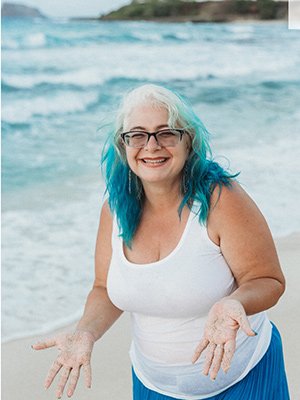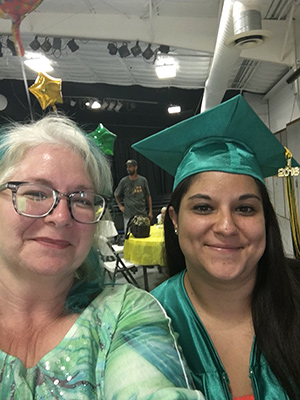
Dominique Chastain
As a new educator in California, Dominique Chastain couldn’t find a permanent teaching position for years, putting her in a catch-22. Without a position, she couldn’t do the Beginning Teacher Support and Assessment training — the second tier of credentialing required by state law. As she came to the end of her extensions, Chastain found a position with the Farmworker Institute of Education and Leadership Development (FIELD). Founded by farmworker leader Cesar Chavez, the nonprofit’s mission is to promote prosperity in rural communities for Latinos, working people, and their families, through basic education.
During a “panicked web search,” Chastain came across SDSU’s online Teacher Induction program for clearing Multiple and Single Subject credentials. The two-year program is accredited by the California Commission on Teacher Credentialing, which sets the standards for professional educators in the state.
“I graduated last year and am so grateful they were willing to work with my unique teaching position with a small population,” says Chastain. “I recommend SDSU’s Teacher Induction program to anyone who will listen! I have told many of the newer teachers in FIELD about this program. I have shared it on Facebook on teacher sites. I nearly lost my credential because I could not get hired by a district that offered BTSA. SDSU was a godsend for me.”
Chastain teaches at FIELD-EPIC de Cesar Chavez High School in Gridley, Calif. She answered a few questions about her career and her journey through SDSU’s program.
Tell us about your classroom with FIELD.
I teach adult high school in rural communities. My class size varies depending on the seasons and low retention rates. In a normal month I have 17 enrolled and might see eight in a given day. Some students are credit-recovery and on individualized plans while others are starting from zero credits in the U.S. and come after work for small-group direct teaching in core classes and English development. My position demands flexibility, multi-level teaching, and administrative capabilities. I am the only teacher here and I see my supervisor about once a month, if not less. It also requires traveling to work sites for vocational ed students, and traveling to Bakersfield and farther down south for professional development where I learn as well as model lessons to other teachers. I am teacher, counselor, principal, custodian, nagging parent figure, a shoulder to cry on, and at times a student.
How did SDSU’s program work with you in your unique position?
The SDSU staff was so very helpful and were great communicators. They helped me when I had questions and were flexible about my student population and the lesson planning. One of the challenges with my position is that I have small class sizes and the students do not all come at once. My small population made it difficult to meet some of the classroom management and levelized lesson planning. At the time, I was up in Grass Valley with an even smaller population of about eight students throughout the day. My students were great about adjusting their schedules on days that I needed a larger group to work with for a lesson and such.
What is levelized lesson planning?
Levelized lesson planning takes into account the different levels my students are at. For example, lessons have to be adaptated for students who are at a bridging level of ELD [English Language Development] versus fluent English speakers. My assessments will be different and some of the practice part of the lesson plan will be different depending on the student or the group of students.
How do you apply what you learned in SDSU’s Teacher Induction program into the classroom?
I am more objective-focused than I was before the program. I definitely have more confidence about using standards as my objective and pulling what materials I need to reach that instead of just using the textbook and teaching what’s in it. Many of our texts are outdated and do not meet the new Common Core standards. What I was taught in the program has really lined up with the professional development FIELD provides to instructors. They provide experts in education and amazing presenters. I definitely see the correlation between what the induction program taught and the real teaching world!

Dominique Chastain and one of her students.
Did the program lead to any “aha” moments?
The tech class, Advanced Teaching and Technology, was incredible. It really opened up my mind to the possibilities. I have become adventurous about technology and probably come in second in terms of how much tech I use as compared to the other teachers. I started out afraid of the class and fell in love with classroom technology instead. My students benefit so much from being pushed to use Google classroom and slides, web links — everything that I can use to integrate computer skills and keep them interested in high school when they have such busy, full lives outside. One of my students, who is a second-language learner with limited tech use, has now been promoted at work and is in charge of data entry for the irrigation information for her crew. Her supervisor talks about the changes she has seen since I took over the class and started pushing computer use.
What are your long-range career plans?
At some point I will most likely move more into teacher training and curriculum development. I am doing some of that now during our workshops. I build my own courses based on our benchmarks, which I helped write during the process of our WASC [Western Association of Schools and Colleges] accreditation. Yes the induction program definitely helped me to be a stronger and more confident teacher. I learned a lot about working with multi-level students and about forming strong lesson plans.
What did you want to be when you grew up?
I was heading into marine biology. However, I was engaged, pregnant, and divorced in a year and a half, which derailed those plans. I managed to get my associate in science degree in horticulture and worked in that field. After several years, I decided to go back to college for teaching. I have always loved being in the classroom!
The application deadline for the Fall 2019 cohort of SDSU’s Teacher Induction program is August 13.




